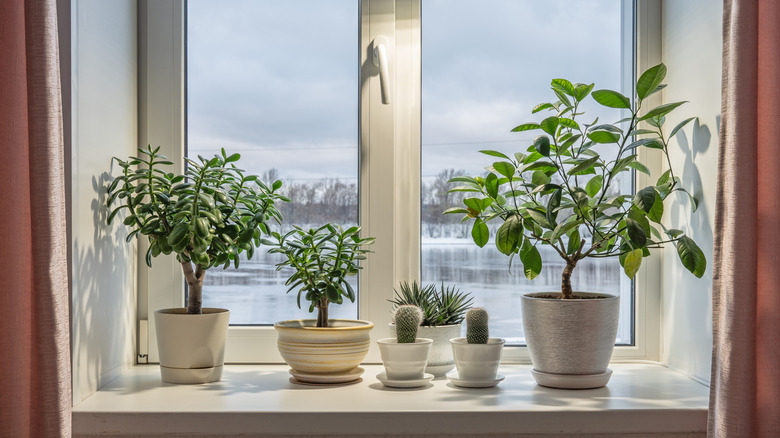How To Keep Your Houseplant's Leaves Looking Their Best In The Winter
The idea of adding something to your winter cleaning list might not sound exciting, but your houseplants will thank you. Cleaning your houseplant's leaves during the winter is among simple tips for keeping your houseplants healthy in any condition. One important reason is photosynthesis, which can't happen when dusty leaves have trouble receiving sunlight. A plant stressed by its inability to feed through photosynthesis is more susceptible to disease than a healthy plant . Winter dust also accumulates on the underside of leaves and can obstruct stomata — specialized cells responsible for regulating water loss through transpiration. At the same time, your house is often more dusty in the winter. Particles kick up from your HVAC system, your pets are staying indoors more, we humans are shedding dry skin cells, and your wood-burning stove produces ash.
In short, cleaning supports the plant's health, stimulates plant growth, and can minimize pests and disease problems. If nothing else, cleaning improves a plant's appearance, and hence, your home's appearance. Tweaking your houseplant care routine for winter by making this part of your routine can also help you spot diseases early. So, how often should you clean your houseplants? Any time you notice a fresh layer of dust.
Keeping plants healthy through regular cleaning
You can clean houseplants in several ways, with plant characteristics dictating the method in some cases. Use lukewarm water for all water-based applications, as both cold and hot water can damage your plants. A good spraying with water in the shower or with a kitchen sink sprayer will work for many plants. For especially dirty plants, mix a spray bottle with 1/4 teaspoon dish detergent diluted in a quart of water. Spray this on the leaves then follow it up by gently rinsing the plant.
For delicate plants that might not stand up to spraying, get a bucket of water, and dip the plant's foliage in it as you hold it at the soil base. It's best to first moisten the soil or placed plastic wrap around it so the plant won't fall out of the pot when inverted. Give plants a swish in the water before removing, and allow the plants to sit and dry before putting them back in place.
Succulents such as cacti and fuzzy-leaved plants like African violets should not get a wet cleaning. Instead, wipe leaves with a soft cloth or use a brush with soft bristles like a paintbrush. Use this treatment on plants too big to move to sink or shower, as well.
This is also a good time to clean up any dead leaves or debris around your houseplants. You should also be cleaning your flower pots any time you notice white salt deposits that have accumulated on the outside of pots by gently scrubbing off the residue. While misting your houseplant foliage can help clean them, don't sub this practice as a replacement for watering or boosting humidity. Misting, in fact, doesn't raise humidity levels and may instead spread disease.

